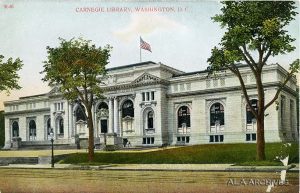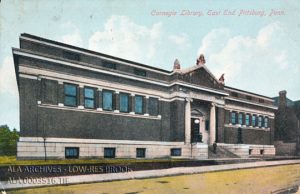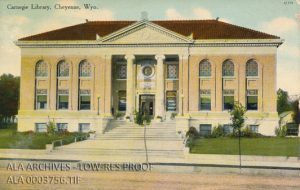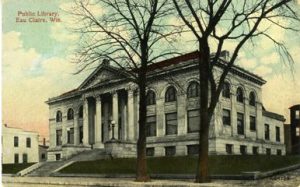The history of public libraries in the United States is as vast and varied as the histories of the towns and cities they inhabit. Despite providing essential services since their inception, the spaces libraries inhabited were not always befitting of their importance. Many were kept in small backrooms or were forced to share space with other local organizations, impeding access to information and depriving citizens of a central gathering space. In this dearth, Andrew Carnegie – an enterprising businessman who at one point was the richest man in the world – saw an opportunity. Between 1893 and 1919, Carnegie gave away $60 million of his fortune to fund 1,689 public libraries across the country [1, 2]. Adjusted for inflation, that figure today reaches towards $1.3 billion. These “Carnegie libraries” became cultural centers in towns big and small and were instrumental in constructing the blueprint of small-town America as we know it today.
These towns were often so proud of these monuments of culture that they distributed postcards celebrating the new library. Many of these postcards, along with thousands of other postcards of libraries around the world, are housed at the American Library Association Archives in the Sjoerd Koopman, Celene Bishop, Judy Muck, and Daniel W. Lester Library Postcard Collections.

The desire to bring open access to information to the masses was a value ingrained in Carnegie from the time he was a bobbin boy in an Allegheny City, Pennsylvania textile mill. Unable to afford either the cost of new books or the $2 subscription fee for an apprentices-only local library, he wrote a letter to library administration asking for access. After the administration’s rebuke, Carnegie got the letter published in a local paper, causing the administration to reverse their decision and allow all working men access to library materials [1]. Former director of the Union County Carnegie Library (2011-2015) Ben Loftis noted that upon receiving $10,000 from Carnegie in 1903, UCCL became the town’s first truly public library. He commented, “It went from being for just the wealthy elite landowners and planters to actually being a service for the entire county that everybody has access to.” [1]

Despite spreading his immense wealth to fund the construction of nearly every American library built before the end of World War II, Carnegie’s legacy of philanthropy is not without its dark marks and paternalistic stances. In an 1889 article published in the North American Review, he commented that “the problem of our age is the proper administration of wealth” and that the wealthiest in society should use their riches to “enable the deserving poor to help themselves.” [2] However, when some of his steelworkers in Homestead, Pennsylvania went on strike for better pay and working conditions, demanding “What good is a book to a man who works 12 hours a day, six days a week?”, Carnegie suppressed their efforts in what has come to be remembered as one of the United States’ most bitter labor disputes [1].
Put in the context of his article in the North American Review, along with one of his most famous writings (“The Gospel of Wealth”), were these workers not trying to better their lot and “help themselves”? Were these workers not the same kinds of people Carnegie had fought so hard for back in the textile mills of Allegheny City, Pennsylvania? When considering the full picture of Carnegie’s immense gift to the institution of public libraries, the incongruity between his professional existence as a calculating, capitalistic industrialist and a generous philanthropist who has been referred to as the “Patron Saint of Libraries” [3] is something that needs to be seriously grappled with.

Despite the allure a Carnegie gift could inspire, some towns refused to take the money. Justifications varied, but according to historian Wayne Wiegand, the overwhelming reasoning was rooted in class consciousness, with one union leader in Wheeling, West Virginia stating that “there will be one place on this great green earth where Andrew Carnegie can’t get a monument with his money.” [4]
These so-called monuments were not just free money – with it came strict design standards and a substantial application process.
Although many Carnegie libraries have similar architectural styles, the particulars of architectural design (and the bloated costs – with potentially no added value to library users – that go along with it) were never a priority for Carnegie. Abigail A. Van Slyck, author of Free to All: Carnegie Libraries & American Culture, 1890–1920, noted that “it would be much better just to get a building, a good one that was efficient that would allow people to access books really readily.” [2] In this way, Carnegie sided with the librarian’s need for a workspace that was both practical for library operations and pragmatically beautiful enough to be prized for generations. Over time, Carnegie and James Bertram, his private secretary, developed “Notes on the Erection of Library Buildings,” a pamphlet that outlined ideal library layout templates (developed in consultation with librarians) and sent to the communities chosen to receive a Carnegie Library grant [2]. These templates provide recommendations on the basic construction of the buildings but offer nothing in the way of design. These recommendations, which most of the grant recipient communities followed, are a major reason why Carnegie libraries look alike, despite the different communities they serve. Some notable commonalities among Carnegie libraries include a community center or auditorium space, a flat back side to the library that would allow for future expansions, and a staircase entrance. While not spectacularly grand, these libraries became a place of pride for communities, and as more towns received grants and constructed libraries, their neighbors wanted in.

Any communities on the receiving end of Carnegie’s money were subject to specific parameters after an extensive application process. In the early days of his library philanthropy, procedures were less formalized, and Carnegie fulfilled grant requests himself. As more and more requests came in, Bertram and the Carnegie Corporation handled all queries. As part of the application, town officials had to outline what they’d be willing to do on their end to provide a long-standing site for the library and support within their community, including raising a tax in support of library operations and the ability for the town to establish permanent funding for library operations and materials. Many towns went above and beyond in their application materials: in Eau Claire, Wisconsin, city officials sent in a robust packet of information that was “part Census form, part tourism brochure, extolling the noble history of Eau Claire while detailing its population, geography, and amenities.” [3] They also included this letter:
“In and by a resolution heretofore unanimously adopted by the Common Council of the City of Eau Claire, Wisconsin, the undersigned were appointed a committee to prepare and present to you, in behalf of the City of Eau Claire and its inhabitants, a request that you give to said City the sum of fifty thousand dollars, or such additional sum or portion thereof, as, in your bounty and good judgment, you deem would be commensurate with the needs and requirements of this City and its inhabitants, to build and construct a suitable building to be devoted to the purpose of maintaining a free library in this City for all future time, to be known as the “Carnegie Library.”

Each interested library received a Schedule of Questions to complete that asked about the town’s population size and whether the town already had a library. Library grants were only given to applicants in English-speaking countries, through an additional $16 million was donated to help in the construction of more than 800 libraries in other countries [4]. By funding the creation of thousands of libraries around the world, Carnegie was able to spread his philosophies and cement his legacy in a way that no single building or company could.
Of all the libraries Carnegie financed, about 70% of them were in small towns. The public interest and excitement sparked by the construction of a Carnegie library was instrumental in generating interest in public libraries all over the United States. “It was an expectation in communities across the country – if you didn’t have a library, somehow you were not supporting culture. Without Carnegie, we’d still have public libraries, but they’d be different and probably fewer in number,” noted Wayne Wiegand, historian and author of Part of Our Lives: A People’s History of the American Public Library [2]. Many of these Carnegie library buildings are still in use – some as museums, city halls, community centers, and 800 are still public libraries. No matter how they are used currently, these buildings stand as symbols of the revolutionary idea that all people, regardless of status or income, deserve access to the same information – housed in a library built to suit their needs and uplift their goals.
[1] Stamberg, Susan. “How Andrew Carnegie Turned His Fortune Into A Library Legacy.” NPR, NPR, 1 Aug. 2013, www.npr.org/2013/08/01/207272849/how-andrew-carnegie-turned-his-fortune-into-a-library-legacy.
[2] Capps, Kriston. “How Andrew Carnegie Built the Architecture of American Literacy.” Bloomberg.com, Bloomberg, 28 Oct. 2014, www.bloomberg.com/news/articles/2014-10-28/how-andrew-carnegie-built-the-architecture-of-american-literacy.
[3] Bobinski, George S. “Carnegie Libraries: Their History and Impact on American Public Library Development.” ALA Bulletin, vol. 62, no. 11, 1968, pp. 1361–1367. JSTOR, www.jstor.org/stable/25698025.
[4] Mitchell, Robert. “Andrew Carnegie Built 1,700 Public Libraries. But Some Towns Refused the Steel Baron’s Money.” The Washington Post, WP Company, 9 Apr. 2018, www.washingtonpost.com/news/retropolis/wp/2018/04/09/andrew-carnegie-built-1700-public-libraries-but-some-towns-refused-the-steel-barons-money/.